Have we mentioned how much we love this place? We love the impromptu street discussions as we unload brains in Portland’s Old Town, we love unscripted engagement on a host of neuroscience topics, from mental health to why some odors might relax you, to whether aspects of magic in fantasy novels are possible in our own physical reality, to what causes vertigo – to why someone might experience “visual trails” under the influence of LSD..!

We had a blast as always talking with exceptional young people who still lack access to safe, secure places to sleep, a critical issue we explored with neuroscience researchers, undergraduate participants, clinicians, policy makers and young houseless youth themselves through a public outreach event last fall called Homelessness and the Brain…

Brains with landscapes, both real and aspirational, above a striking portrait of street performer John “Elvis” Schroder, all by youth @ p:ear (Elvis to hang soon @ Voodoo Donuts)

LEARN MORE: Landscapes of the Brain: Seeing us all through research & art
LEARN MORE: John “Elvis” Schroder

Justin Navarro, Aaron Eisen and Ashley Keates from Psychology at Portland State University joined today’s crew, and we swiveled heads and brains with the giant styrofoam Noggin carved by Ashley and Max Barsana, an artist who also crafted characters for “The Boxtrolls” and the new Missing Link at Laika Studios..!
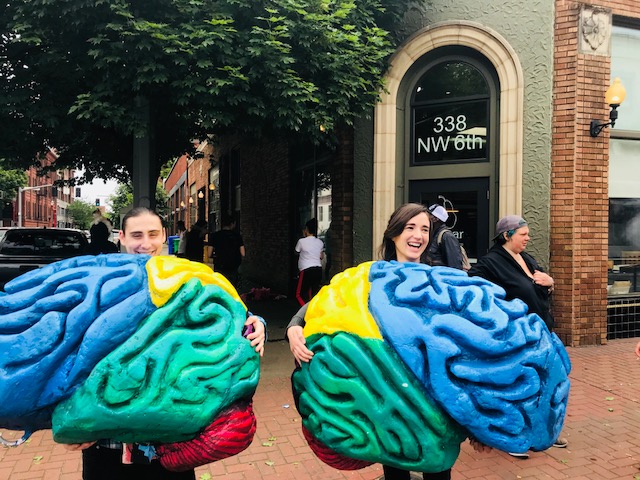
LEARN MORE: Building a Brain for Science
We enjoyed painting more brain regions from our plywood cutouts of lateral cortex…
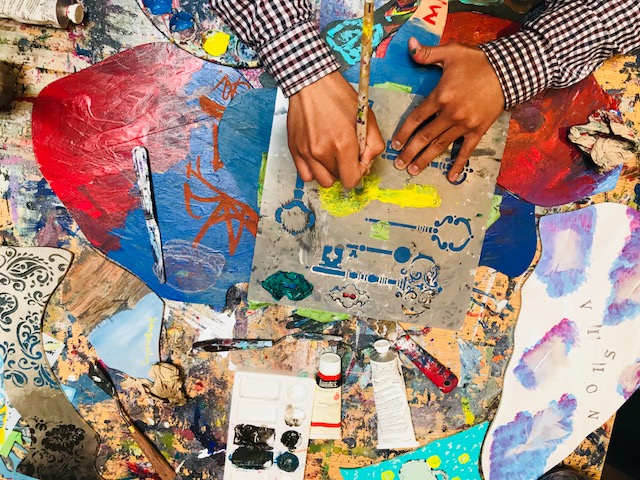
More objects, some stenciled, landed in the visual “what pathway” of the temporal lobe…

WHAT pathway (temporal lobes): “It’s a Dalek”
WHERE pathway (parietal lobes): “And it’s right there”
OTHER BRAIN AREAS (e.g., amygdala): “!!!!”
LEARN MORE: Tagging the temporal lobe
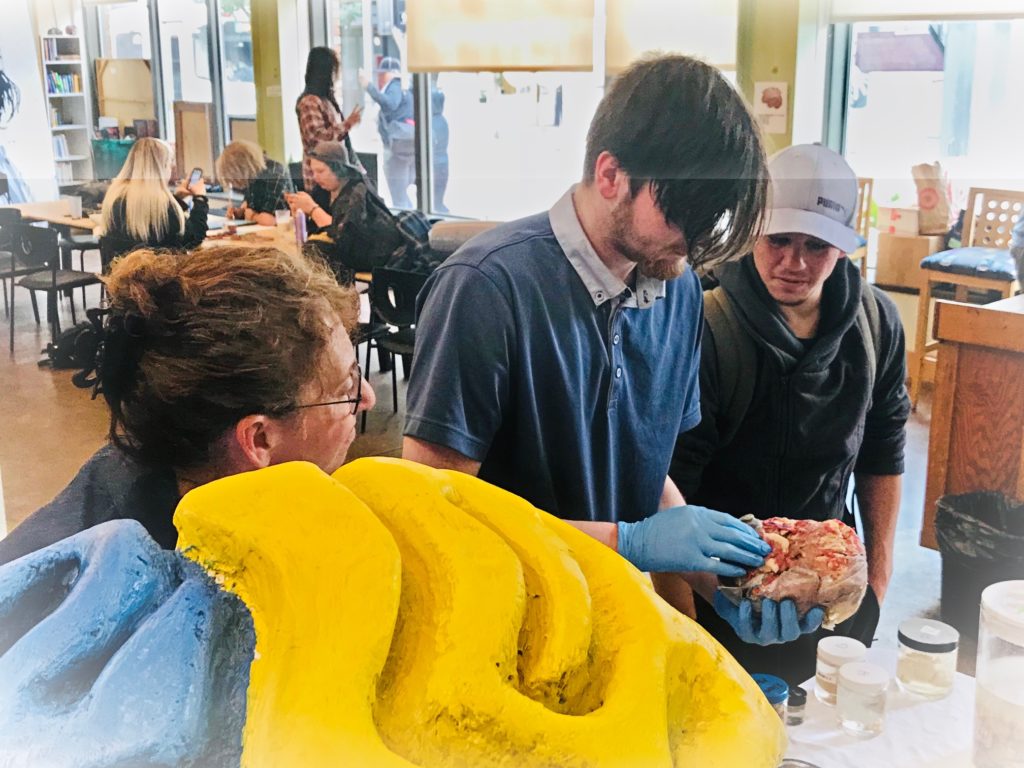
So what can perceptual distortions like “visual trails” – the strobe-like conversion of a smoothly moving object into an often jarring sequence of still images associated with the use of certain drugs (including LSD, and perhaps select anti-depressants) – reveal about our brains? What does this tell us about visual consciousness?

Multiple Exposure of Alicia Alonso, by Gjon Mili. Visual trails can be something like this…
LEARN MORE: How Gjon Mili Pioneered Stop-Motion Photography
LEARN MORE: Gjon Mili and the Science of Movement
We wrote about the basics of vision, and how our eyes detect and distribute the narrow sliver of electromagnetic energy reflected off objects after discussing hallucinations during a recent Noggin visit to Vancouver’s HeLa High…
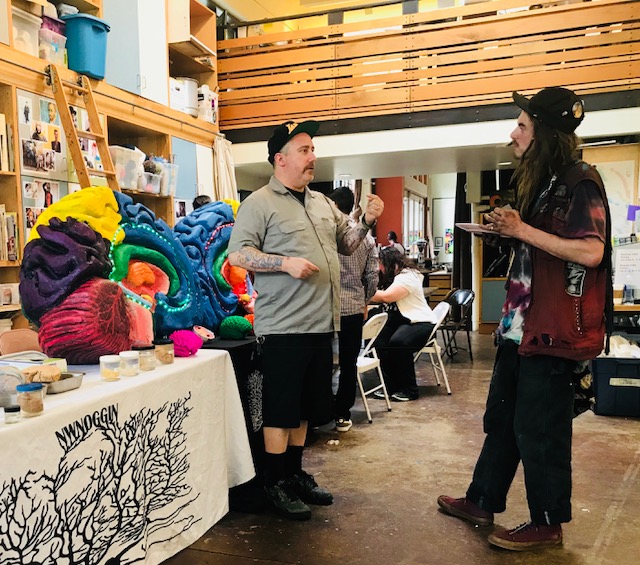
LEARN MORE: Hallucinations @ HeLa High
Visual perception, however, is not the same as sensory detection by the light absorbing cells (photoreceptors) in your eyes, and relies instead on neural networks in cortical areas of the brain. Networks in the temporal lobes (known as the “what pathway“) underlie perceptions of what you see, be it faces, dogs, bikes – or brains. Visual information arriving in the parietal lobes (via portions of the temporal lobe) inform touch and positional maps of your body about where objects are in relation to you. This is called the “where pathway…”

However, before reaching visual cortex at the back of your head in the occipital lobes (paradoxically the chunk of cortex farthest from your eyes), activity detected by those photoreceptors is processed first by neurons in a centrally located brain region called the thalamus. Thalamic brain cells send their own wiry axons into primary visual cortex (V1), and V1 sends lots of axonal feedback to the thalamus (those arrows above go both ways).
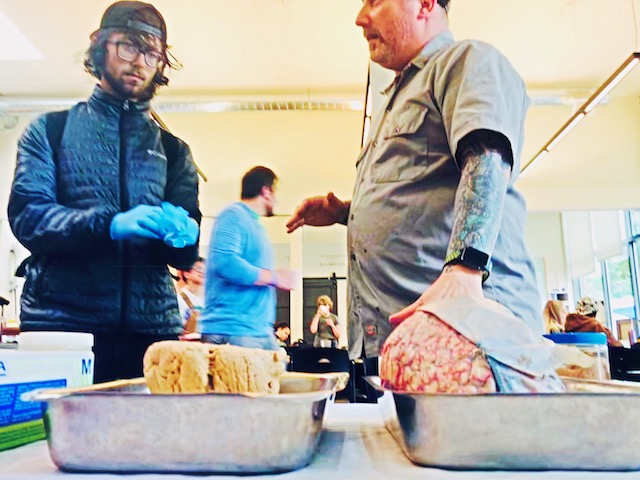
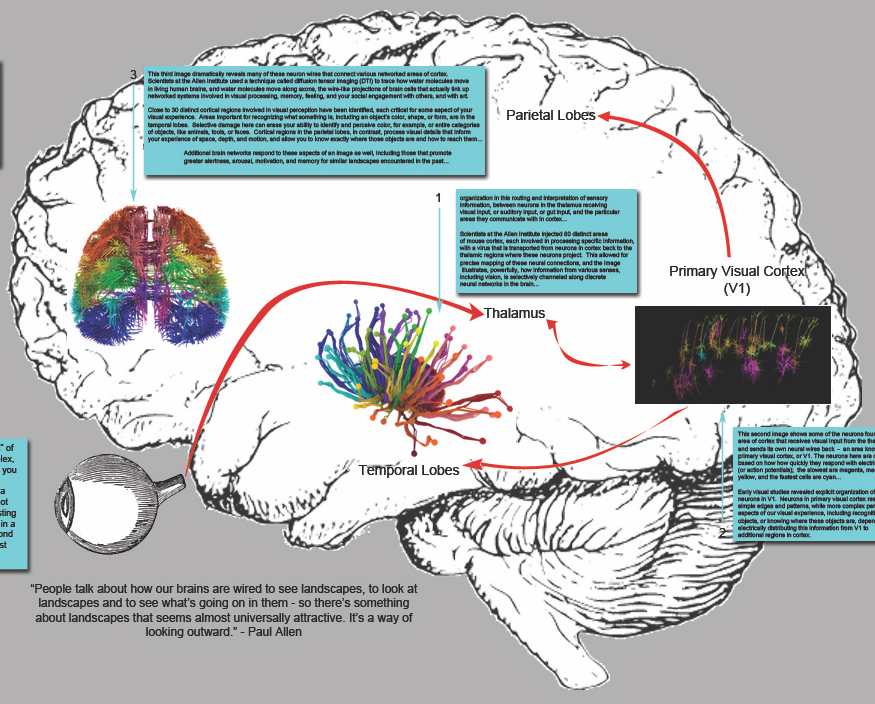
The thalamus (“chamber” in Greek) handles more than vision. Different clumps of thalamic neurons (different “gray matter” nuclei) initially process different kinds of incoming sensory information – from your ears, body, tongue, inner ear – and distribute all that information to different areas of cortex!

In the image above, from the Allen Institute for Brain Science, you’re seeing specific areas of cortex in different lobes (the colored circles) that receive input and send feedback to discrete nuclei in the thalamus (the kidney shaped structure in the middle), processing and distributing information about our different senses, including vision, hearing, touch,…
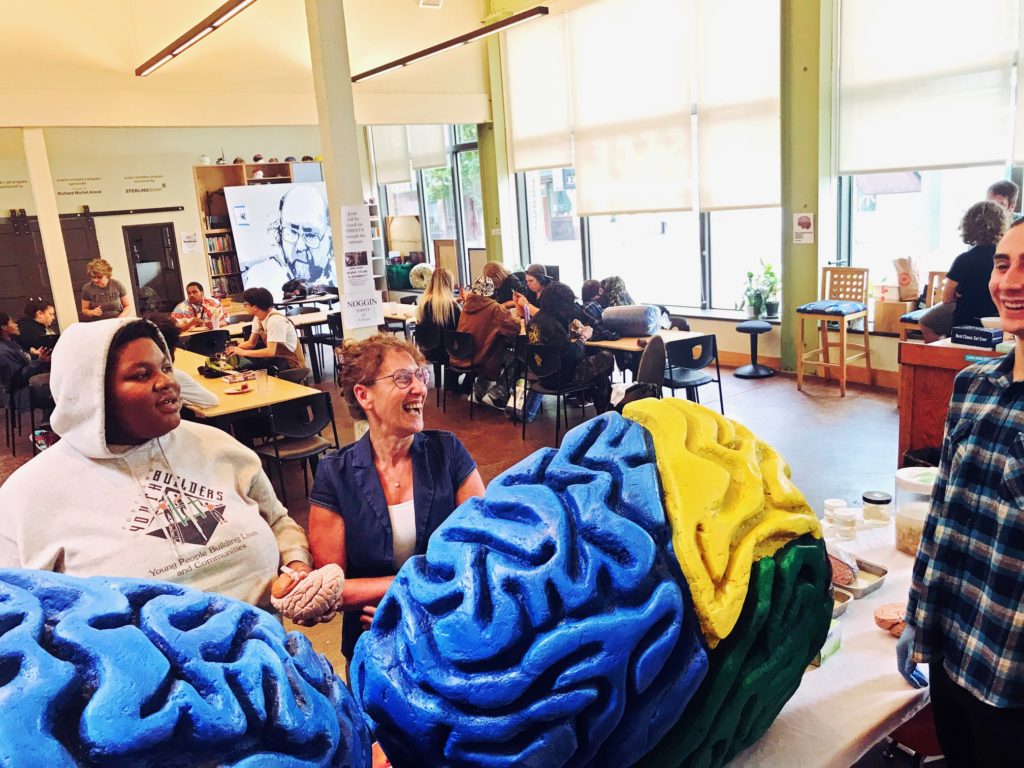
LEARN MORE: The role of the thalamus in the flow of information to the cortex
LEARN MORE: The Nature of Seeing: Noggins and Art
To experience a perceptual moment, your brain needs to combine sensory inputs from multiple sources – visual, auditory, touch, position, taste – and these inputs are arriving along multiple wired channels at different rates. Light, of course, reaches your photoreceptors at the very rapid speed of light, while sound waves travel more slowly, with more subcortical synapses before the thalamus, and then cortex. Your brain delays the visual perception of, say, someone talking, to perceptually match with slower to arrive sounds of their speech. These complex integrative networks are most certainly affected by LSD…

LEARN MORE: Hallucinogens
LEARN MORE: Clinical Applications of Hallucinogens: A Review
LEARN MORE: Recent Advances in the Neuropsychopharmacology of Serotonergic Hallucinogens

LSD is a synthetic hallucinogen first synthesized by Albert Hoffman, a scientist working for Sandoz Pharmaceuticals in Switzerland in 1938. He personally (and accidentally) discovered its powerful effects in 1943.

LEARN MORE: ‘Apparently Useless’: The Accidental Discovery of LSD
LEARN MORE: Albert Hofmann, the Father of LSD, Dies at 102
So how does LSD exert such dramatic influence over perception and cognitive experience..?
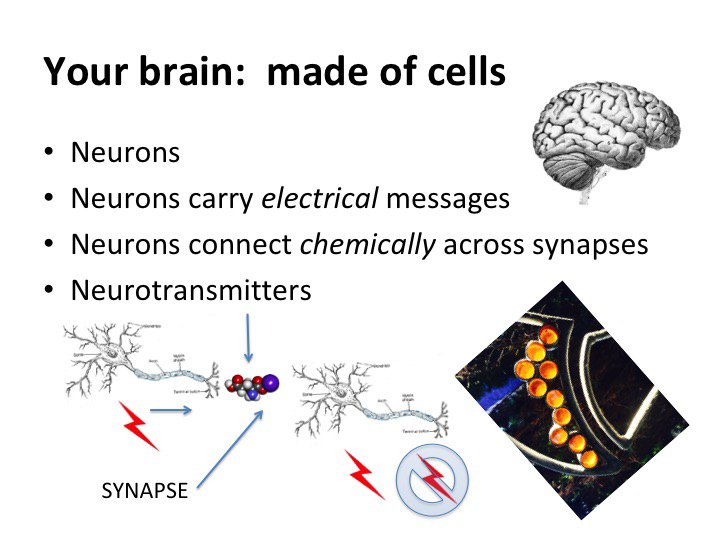
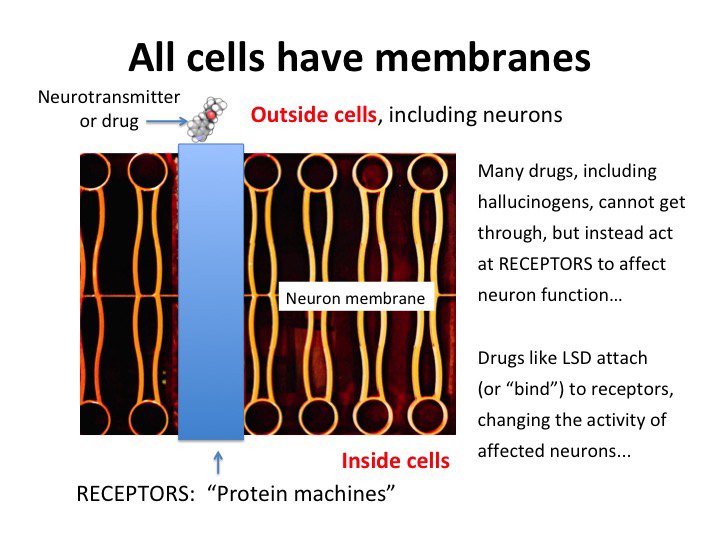
LSD (and other drugs) act on protein receptors embedded in cell membranes at synapses – receptors that typically respond to a neurotransmitter (like serotonin) released by one neuron to communicate with the next. There are fifteen different kinds of serotonin receptors, but hallucinogens preferentially act on one. LSD is VERY GOOD at activating this one receptor (serotonin 5-HT2A), so it doesn’t take much drug to have an effect…

Recent studies have revealed more precisely how LSD engages with the 5-HT2A serotonin receptor…

LSD (red) docked in its receptor (white ribbon). X-ray crystallography imaging revealed the arrangement of atoms in the molecules. From Crystal Structure of an LSD-Bound Human Serotonin Receptor…
LEARN MORE: Protein structure reveals how LSD affects the brain
So a critical question is: WHERE are all these 5-HT2A serotonin receptors (all these targets of LSD and other hallucinogens) actually found in our brains?
The human thalamus has a few of these receptors, so perhaps LSD impacts some sensory processing here…

However, there are far more of these serotonin receptors in cortex, including an older region called the hippocampus in the middle (or medial) part of the temporal lobes, which is essential for visuo-spatial memory. The “subcortical” (below the cortex) basal ganglia are also packed with targets for LSD, and play a crucial role in the timing and integration of behavior. From one recent article, “Abnormal 5-HT2AR activity is associated with a number of psychiatric disorders and conditions, including depression, schizophrenia, and drug addiction.”

LEARN MORE: The role of serotonin 5-HT2A receptors in memory and cognition
LEARN MORE: Myelination @ Madison
There are a few hypotheses to explain how LSD disruption of sensory and perceptual processing (in thalamus, cortex, basal ganglia and elsewhere) might lead to the visual trails experience. The role of rhythmicity, periodicity and precise timing in the integration of all these disparate signals into coherent perceptual moments is one area of great interest…

Multiple-exposure stroboscopic photograph, from Visual Trails (PLoS Biology, 2011)
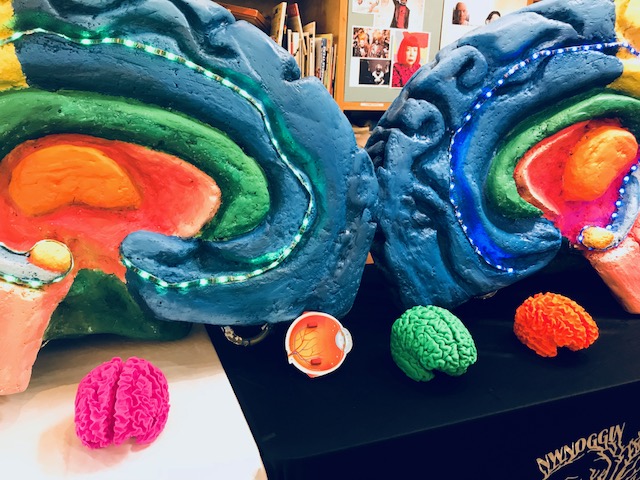

LEARN MORE: The neural basis of temporal processing
From a recent research article on this topic, “Visual trails, because of their discrete and repetitive nature, may represent the perceptual manifestation of an underlying periodic process…(that) may be the result of faulty motion computation mechanisms (e.g., motion smear suppression), or…may point to a more general, quasi-periodic sampling process that affects, among other things, the motion perception system.”

LEARN MORE: Visual Trails: Do the Doors of Perception Open Periodically?
“So wait…are you saying that what I feel now, here, in front of me – is a mix of different senses created and organized by my brain, that happened already – in the past?!” Yes, we replied.

Exploring the neuroscience of hallucinogens (and perhaps viewing the art of stop motion photography) might just be trippier and more fascinating than drugs!

LEARN MORE: Modern Clinical Research on LSD
Many, many thanks to our community minded outreach volunteers, and to Will Kendall and the terrific staff and young artists and developing scientists at the incomparable p:ear…
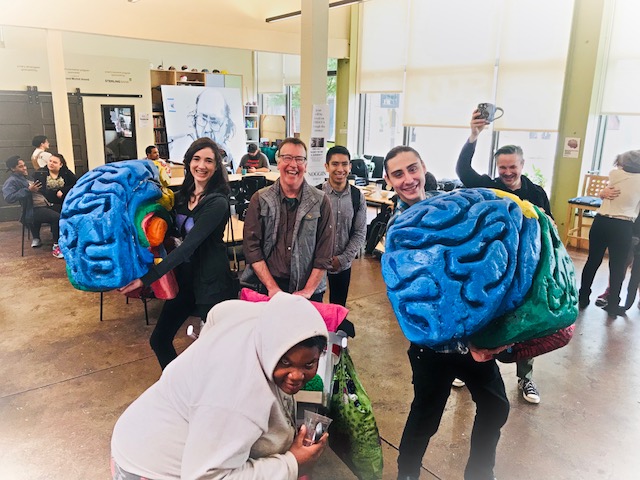
JOIN US on future p:ear visits: REGISTER FOR VOLUNTEER TRAINING 5/19/18


